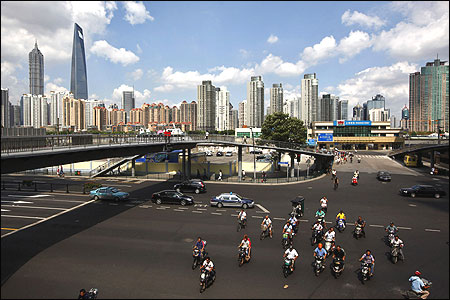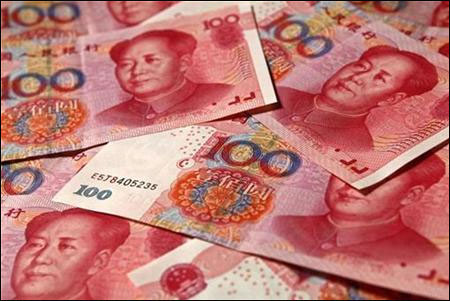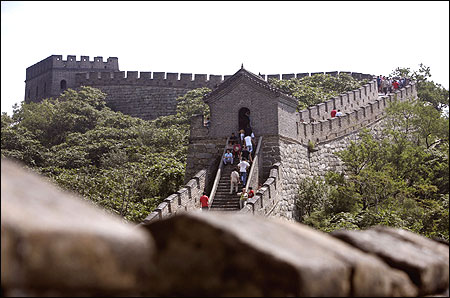Photographs: Getty Images Shankar Sharma and Devina Mehra
For years, a wispy, gossamer dream has been spun by economists working for Wall Street investment banks about how China has managed the impossible: high growth with a very low debt-to-GDP ratio.
The dream has been so aggressively sold that almost everybody believes it, including editors of this newspaper who have written glowingly about China's growth, how far ahead it is of India, how India should give up this race once and for all and so on.
Click on NEXT for more...
China
Image: A view of the centre of Shanghai, near the Pudong Lujiazui financial area.Photographs: Aly Song/Reuters
Like all things churned out by Wall Street, this romantic story is also complete rubbish.
Regardless of the level of education, we all behave the same way when we analyse countries: we land at the airport, see multi-lane highways, gleaming skyscrapers in the city centre, massive infrastructure development, teeming shopping malls, tall apartment blocks and golf courses.
And immediately jump to the conclusion that this country has done it. It has made it.
If you are an Indian, you say this country has left India behind by 100 or 200 years.
Click on NEXT for more...
China's $22 trillion time-bomb
Image: A boy holds a Republic of Ireland flag during a St Patrick's day march.Photographs: Stefan Wermuth/Reuters
But it is instructive to remember what a crafty villain in an old Hindi movie said: "Har badi kaamyabi ke peeche koi gunaah chhupa hai..." (Behind every great success, lies hidden a great crime).
Just as behind nearly every rapid economic growth story, lies hidden, debt.
Usually lots of it. Just like Ireland that went from being a really poor country in the 1980s to getting to the top of European Union's per capital GDP league tables - all within 20 years or so.
Click on NEXT for more...
China's $22 trillion time-bomb
Image: A member of staff stands in front of a CRH high-speed train at Shanghai Hongqiao Railway Station.Photographs: Getty Images.
China is no exception.
The common wisdom is that China runs a very low debt-to-GDP ratio of around 30 per cent (this ratio was in the low 20s till 2007 but jumped sharply during the 2008 crisis), which gives it lots of firepower to keep reflating the economy and to keep recapitalising its banks.
The reality is that this ratio is plain wrong. China's growth model is based on the oldest rapid economic growth hormone available: debt.
Click on NEXT for more...
China's $22 trillion time-bomb
Photographs: Getty Images.
China has debt at various levels and pockets. Let's add to this central debt, the local government and provincial debt figures.
This figure is around $1.9 trillion. Let's further add the obligations of the Ministry of Railways. That's $360 billion. And finally let's also add 80 per cent of outstanding bank credit.
This adds $6.3 trillion. We add bank loans to national debt because unlike most countries, China uses banks for nearly all of its directed, policy lending programmes.
For example, the stimulus of 2008-09 was financed largely by banks. By pushing its lending via the banks' balance sheets, China creates the impression of a country that has very low budget deficits and, of course, very low central debt.
We take 80 per cent of bank debt into the national debt figures under the assumption that 20 per cent goes towards consumer and private sector credit.
Click on NEXT for more...
China
Image: Tourists walk around a giant red lantern on display at Tiananmen Square for the National Day celebrations.Photographs: Reuters
Now let's total up the few trillions we have unearthed. As of 2011, this figure amounted to a tad over $10 trillion!
And the ratio of total debt to GDP becomes a more ominous 149 per cent.
Mind you, there may be other debts that are obligations of the central government that we don't know about since reliability of data in China is suspect, to say the least.
It is eminently possible that debt is understated and GDP overstated.
Click on NEXT for more...
China's $22 trillion time-bomb
Image: Tourists walk around a giant red lantern on display at Tiananmen Square for the National Day celebrations.Photographs: Jason Lee/Reuters
But the story gets worse from hereon. China's growth model is highly capital or, more accurately, debt intensive.
We have calculated a ratio called DIG (debt intensity of GDP), that is, the amount of debt needed to generate one unit of GDP.
This ratio started out being in the 0.9 to 1.2 range in the first half of the nineties.
During the Asian crisis, this ratio worsened to around two as China again threw loads of debt to come out of the slowdown.
The ratio subsided a bit to below one in the boom years from 2003 to 2007. But it jumped dramatically to over four in 2008 as China threw a huge amount of money at an unprecedented slowdown.
Click on NEXT for more...
China's $22 trillion time-bomb
The trouble is that given the overall low growth environment globally and the worsening trade situation for China, generating a unit of GDP growth now requires higher and higher doses of debt.
And, in hindsight, we will look back and say this stimulus of 2008-09 was a colossal mistake.
So what does the DIG ratio lead us to? See the table.
As we can see, each crisis leads to a worsening of the DIG ratio and, concomitantly, a sharp worsening of the total debt-to-GDP ratio as China starts building bridges and roads to nowhere in order to reflate.
Click on NEXT for more...
China's $22 trillion time-bomb
Image: Tourists take pictures at the "white elephant dance" folk performance at a tourism resort in Jinggu county, Yunnan province.Photographs: Wong Campion/Reuters
The bigger problem lies ahead. Given this inclined treadmill model, if China grows faster, the bigger the debt problem becomes.
For the sake of calculation, let's assume the DIG ratio goes to 1.7 over the next four years till 2016 and that China wishes to grow at eight per cent.
The total debt-to-GDP ratio at the end of 2016 becomes 180 per cent, up from the 150 per cent of 2011! In absolute terms, China's total debt will reach $22 trillion.
Coupled with a worsening demographic picture, this high total debt-to-GDP ratio becomes a trap from which there is virtually no escape.
Click on NEXT for more...
China's $22 trillion time-bomb
Image: A seller arranges nuts in a market on East Street, of Xi'an.Photographs: Reuters
To compound the problem, China's private consumption expenditure (PCE) to GDP has declined sharply to 33 per cent from 55 per cent 20 years ago.
The ratio of net exports to GDP has fallen to 3.9 per cent in 2010, from 8.8 per cent in 2007.
It's only the ratio of gross fixed capital formation to GDP that has jumped to over 50 per cent in 2011 from 25 per cent a few years ago.
As is clear, if China has to maintain its pace of growth, it has to pile on more debt. If it slows down, its social powder keg starts getting incendiary.
Click on NEXT for more...
China's $22 trillion time-bomb
Image: Tourists walk along the Mutianyu section of the Great Wall in Huairou District, Beijing.Photographs: Deurbon Chow/Reuters
We are not even counting the burgeoning, widespread non-performing loans problem that is looming large and will, in all probability, lead to China's fourth systemic banking crisis in less than 25 years.
If this is a growth model, then it is even worse than the Western growth model.
Click on NEXT for more...
China's $22 trillion time-bomb
Image: A vendor slices pineapple along the sidewalk in the central business district of Beijing.Photographs: Claro Cortes/Reuters
So, the bullets China has in order to emerge from this rock-and-a-hard-place situation are few, if any at all. China is indeed riding the tiger.
In contrast, India's is the Toyota Prius of growth models. India should simply avoid the trap of excessive public spending on infrastructure.
That's where almost every country in Asia, including Japan in the nineties to China and Dubai now, has run into problems.
India's growth model is infinitely more robust and time will prove this to a world bedazzled by China.
The authors work at First Global














article